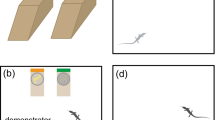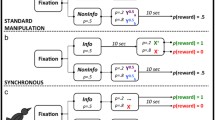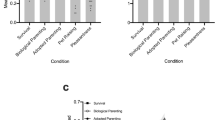Abstract
Prior work has demonstrated that young children in the US and the Ecuadorian Amazon preferentially remember information about the dangerousness of an animal over both its name and its diet. Here we explore if this bias is present among older children and adults in Fiji through the use of an experimental learning task. We find that a content bias favoring the preferential retention of danger and toxicity information continues to operate in older children, but that the magnitude of the bias diminishes with age and is absent in adults. We also find evidence that fitness costs likely impact the types of mistakes that participants make in their attributions of dangerousness and poisonousness. These results suggest that natural selection has shaped the way in which we learn and make inferences about unfamiliar animal species over ontogeny, and that future research is needed on how content biases may vary across the life course.


Similar content being viewed by others
References
Atran, S. (1998). Folk biology and the anthropology of science: cognitive universals and cultural particulars. Behavioral and Brain Sciences, 21(04), 547–569.
Barrett, H. C. (2004). Cognitive development and the understanding of animal behavior. In B. Ellis & D. Bjorklund (Eds.), Origins of the social mind (pp. 438–467). New York: Guilford.
Barrett, H. C. (2005). Adaptations to predators and prey. In D. M. Buss (Ed.), The handbook of evolutionary psychology (pp. 200–223). New York: Wiley.
Barrett, H. C., & Broesch, J. (2012). Prepared social learning about animals in children. Evolution and Human Behavior, 33(5), 499–508.
Barrett, J. L., & Nyhof, M. A. (2001). Spreading non-natural concepts: the role of intuitive conceptual structures in memory and transmission of cultural materials. Journal of Cognition & Culture, 1(1), 69–100.
Bates, D., & Maechler, M. (2010). lme4: Linear mixed-effects models using S4 classes. http://CRAN.R-project.org/package=lme4.
Bird, D., & Bliege Bird, R. (2002). Children on the reef. Human Nature, 13(2), 269–297. doi:10.1007/s12110-002-1010-9.
Blurton Jones, N., & Konner, M. J. (1976). !Kung knowledge of animal behavior. In R. B. Lee & I. DeVore (Eds.), Studies of the !Kung San and their neighbors. Cambridge: Harvard University Press.
Boyd, R., & Richerson, P. J. (1985). Culture and the evolutionary process. Chicago: University of Chicago Press.
Boyd, R., & Richerson, P. J. (2005). The origin and evolution of cultures. Oxford, New York: Oxford University Press.
Boyer, P. (1998). Cognitive tracks of cultural inheritance: how evolved intuitive ontology governs cultural transmission. American Anthropologist, 100(4), 876–889. doi:10.1525/aa.1998.100.4.876.
Boyer, P., & Ramble, C. (2001). Cognitive templates for religious concepts: cross-cultural evidence for recall of counter-intuitive representations. Cognitive Science, 25, 535–564. doi:10.1207/s15516709cog2504_2.
Carver, R. P. (1978). The case against statistical significance testing. Harvard Educational Review, 48(3), 378–399.
Chudek, M., Brosseau-Liard, P., Birch, S., & Henrich, J. (2012). Prestige-biased cultural learning: bystander’s differential attention to potential models influences children’s learning. Evolution and Human Behavior, 33, 46–56. doi:10.1016/j.evolhumbehav.2011.05.005.
Fessler, D. M. T. (2006). A burning desire: steps toward an evolutionary psychology of fire learning. Journal of Cognition and Culture, 6, 429–451. doi:10.1163/156853706778554986.
Fessler, D. M. T., & Navarrete, C. D. (2003). Meat is good to taboo: dietary proscriptions as a product of the interaction of psychological mechanisms and social processes. Journal of Cognition and Culture, 3, 1–40. doi:10.1163/156853703321598563.
Garcia, J., & Koelling, R. A. (1966). Relation of cue to consequence in avoidance learning. Psychonomic Science, 3, 123.
Gardner, M. J., & Altman, D. G. (1986). Confidence intervals rather than P values: estimation rather than hypothesis testing. British Medical Journal (Clinical research ed.), 292(6522), 746–750. doi:10.1136/bmj.292.6522.746.
Haselton, M. G., & Nettle, D. (2006). The paranoid optimist: an integrative evolutionary model of cognitive biases. Personality and Social Psychology Review, 10(1), 47–66. doi:10.1207/s15327957pspr1001_3.
Heath, C., Bell, C., & Sternberg, E. (2001). Emotional selection in memes: the case of urban legends. Journal of Personality and Social Psychology, 81(6), 1028–1041. doi:10.1037/0022-3514.81.6.1028.
Henrich, J. (2009). The evolution of costly displays, cooperation, and religion: credibility enhancing displays and their implications for cultural evolution. Evolution and Human Behavior, 30, 244–260. doi:10.1016/j.evolhumbehav.2009.03.005.
Henrich, J., & Henrich, N. (2010). The evolution of cultural adaptations: Fijian food taboos protect against dangerous marine toxins. Proceedings of the Royal Society B: Biological Sciences, 277(1701), 3715–3724. doi:10.1098/rspb.2010.1191.
Henrich, J., & McElreath, R. (2003). The evolution of cultural evolution. Evolutionary Anthropology, 12(3), 123–135. doi:10.1002/evan.10110.
Lavie, N. (2005). Distracted and confused? Selective attention under load. Trends in Cognitive Sciences, 9, 75–82. doi:10.1016/j.tics.2004.12.004.
Liebenberg, L. (1990). The art of tracking: The origin of science. Where? South Africa: David Philip Publishers.
McNamara, J. M., & Houston, A. I. (1992). Risk-sensitive foraging: a review of the theory. Bulletin of Mathematical Biology, 54(2), 355–378.
Medin, D. L., & Atran, S. (Eds.). (1999). Folk biology. Cambridge, MA: Bradford.
Mesoudi, A. (2009). How cultural evolutionary theory can inform social psychology and vice versa. Psychological Review, 116(4), 929–952. doi:10.1037/a0017062.
Mineka, S., & Cook, M. (1988). Social learning and the acquisition of snake fear in monkeys. In T. R. Zentall (Ed.), Social learning: Psychological and biological perspectives (pp. 51–72). New York: Routledge.
Nairne, J. S., Pandeirada, J. N. S., Gregory, K. J., & Van Arsdall, J. E. (2009). Adaptive memory: fitness relevance and the hunter-gatherer mind. Psychological Science, 20(6), 740–746. doi:10.1111/j.1467-9280.2009.02356.x.
Nakahashi, W., Wakano, J. Y., & Henrich, J. (2012). Adaptive social learning strategies in temporally and spatially varying environments. Human Nature, 23, 386–418. doi:10.1007/s12110-012-9151-y.
Norenzayan, A., Atran, S., Faulknera, J., & Schaller, M. (2006). Memory and mystery: the cultural selection of minimally counterintuitive narratives. Cognitive Science, 30(3), 531–553. doi:10.1207/s15516709cog0000_68.
Öhman, A., & Mineka, S. (2001). Fears, phobias, and preparedness: toward an evolved module of fear and fear learning. Psychological Review, 108(3), 483–522. doi:10.1037/0033-295X.108.3.483.
Öhman, A., Flykt, A., & Esteves, F. (2001). Emotion drives attention: detecting the snake in the grass. Journal of Experimental Psychology, 130(3), 466–478. doi:10.1037/0096-3445.130.3.466.
R Development Core Team. (2010). R: A Language and Environment for Statistical Computing. Vienna, Austria: R Foundation for Statistical Computing.
Rendell, L., Fogarty, L., Hoppitt, W. J. E., Morgan, T. J. H., Webster, M. M., & Laland, K. N. (2011). Cognitive culture: theoretical and empirical insights into social learning strategies. Trends in Cognitive Sciences, 15(2), 68–76. doi:10.1016/j.tics.2010.12.002.
Scalise Sugiyama, M. (2001). Food, foragers, and folklore: the role of narrative in human subsistence. Evolution and Human Behavior, 22(4), 221–240. doi:10.1016/s1090-5138(01)00063-0.
Seligman, M. E. P. (1970). On the generality of the laws of learning. Psychological Review, 77, 406–418. doi:10.1037/h0029790.
Sperber, D. (1996). Explaining culture: A naturalistic approach. Cambridge: Blackwell.
Tooby, J., & Cosmides, L. (1992). The psychological foundations of culture. In J. Barkow, L. Cosmides, & J. Tooby (Eds.), The adapted mind: Evolutionary psychology and the generation of culture. New York: Oxford University Press.
Acknowledgments
The authors wish to thank the people of Yasawa and Totoya who participated in this study. The authors also wish to thank the Department of Anthropology at Emory University, the National Science Foundation (PECASE Award Number: 0239683), and the Robert Wood Johnson Foundation Health & Society Scholars program for their financial support.
Author information
Authors and Affiliations
Corresponding author
Electronic supplementary material
Below is the link to the electronic supplementary material.
ESM
(DOCX 23.7 kb)
Rights and permissions
About this article
Cite this article
Broesch, J., Barrett, H.C. & Henrich, J. Adaptive Content Biases in Learning about Animals across the Life Course. Hum Nat 25, 181–199 (2014). https://doi.org/10.1007/s12110-014-9196-1
Published:
Issue Date:
DOI: https://doi.org/10.1007/s12110-014-9196-1




